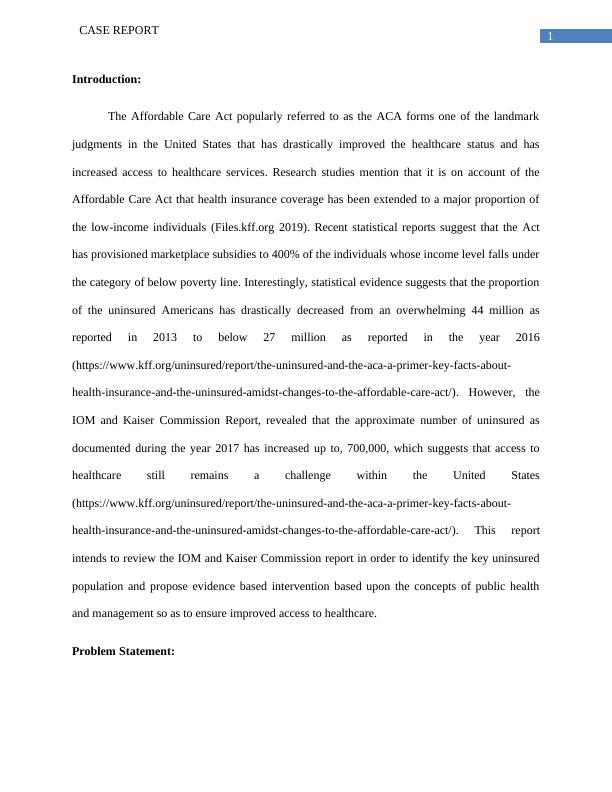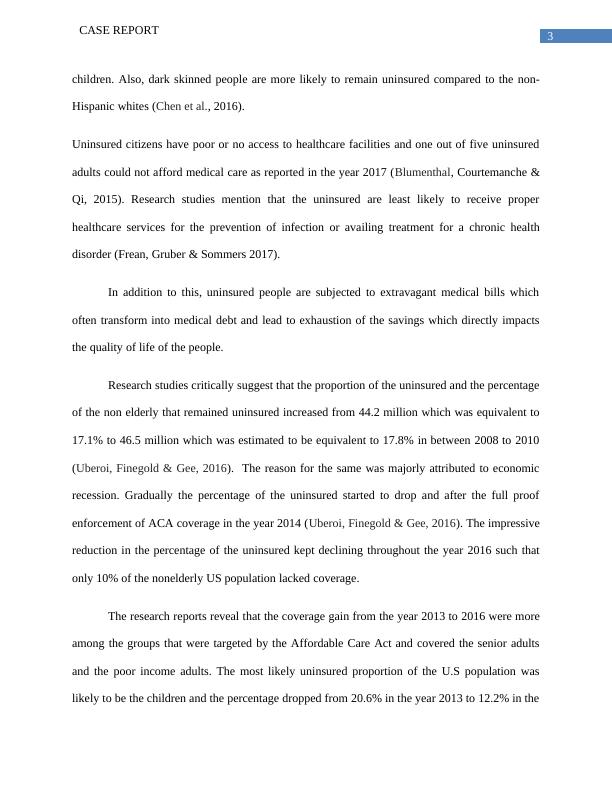Improving Access to Healthcare for Uninsured Population in the US
Added on 2022-11-16
13 Pages3822 Words125 Views
Running head: CASE REPORT
CASE REPORT
Name of the Student:
Name of the University:
Author Note:
CASE REPORT
Name of the Student:
Name of the University:
Author Note:

1CASE REPORT
Introduction:
The Affordable Care Act popularly referred to as the ACA forms one of the landmark
judgments in the United States that has drastically improved the healthcare status and has
increased access to healthcare services. Research studies mention that it is on account of the
Affordable Care Act that health insurance coverage has been extended to a major proportion of
the low-income individuals (Files.kff.org 2019). Recent statistical reports suggest that the Act
has provisioned marketplace subsidies to 400% of the individuals whose income level falls under
the category of below poverty line. Interestingly, statistical evidence suggests that the proportion
of the uninsured Americans has drastically decreased from an overwhelming 44 million as
reported in 2013 to below 27 million as reported in the year 2016
(https://www.kff.org/uninsured/report/the-uninsured-and-the-aca-a-primer-key-facts-about-
health-insurance-and-the-uninsured-amidst-changes-to-the-affordable-care-act/). However, the
IOM and Kaiser Commission Report, revealed that the approximate number of uninsured as
documented during the year 2017 has increased up to, 700,000, which suggests that access to
healthcare still remains a challenge within the United States
(https://www.kff.org/uninsured/report/the-uninsured-and-the-aca-a-primer-key-facts-about-
health-insurance-and-the-uninsured-amidst-changes-to-the-affordable-care-act/). This report
intends to review the IOM and Kaiser Commission report in order to identify the key uninsured
population and propose evidence based intervention based upon the concepts of public health
and management so as to ensure improved access to healthcare.
Problem Statement:
Introduction:
The Affordable Care Act popularly referred to as the ACA forms one of the landmark
judgments in the United States that has drastically improved the healthcare status and has
increased access to healthcare services. Research studies mention that it is on account of the
Affordable Care Act that health insurance coverage has been extended to a major proportion of
the low-income individuals (Files.kff.org 2019). Recent statistical reports suggest that the Act
has provisioned marketplace subsidies to 400% of the individuals whose income level falls under
the category of below poverty line. Interestingly, statistical evidence suggests that the proportion
of the uninsured Americans has drastically decreased from an overwhelming 44 million as
reported in 2013 to below 27 million as reported in the year 2016
(https://www.kff.org/uninsured/report/the-uninsured-and-the-aca-a-primer-key-facts-about-
health-insurance-and-the-uninsured-amidst-changes-to-the-affordable-care-act/). However, the
IOM and Kaiser Commission Report, revealed that the approximate number of uninsured as
documented during the year 2017 has increased up to, 700,000, which suggests that access to
healthcare still remains a challenge within the United States
(https://www.kff.org/uninsured/report/the-uninsured-and-the-aca-a-primer-key-facts-about-
health-insurance-and-the-uninsured-amidst-changes-to-the-affordable-care-act/). This report
intends to review the IOM and Kaiser Commission report in order to identify the key uninsured
population and propose evidence based intervention based upon the concepts of public health
and management so as to ensure improved access to healthcare.
Problem Statement:

2CASE REPORT
The percentage of uninsured has increased up to 700,000 within the United States since
2017. The rise in the number of the uninsured has been reported the highest post the
implementation of the Affordable Care Act in the year 2017. Research reports reveal that
previously the public insurance system acted as a predominant barrier that reduced access to
affordable healthcare to millions of the U.S citizens. The first half of 2014, marked the
enforcement of the Affordable Care Act that helped to improve healthcare access to a major
proportion of the U.S citizens that were previously uninsured (Joseph et al., 2016). In addition to
this, health insurance marketplaces also helped to improve medical aid coverage to millions.
Statistical evidence strikingly reveals an impressive decrease in the number of the uninsured who
are covered under the ACA and increase in the public as well as private insurance coverage
(Sommers et al., 2015). At present, it is stated that approximately 20 million U.S citizens are
insured and covered under the Affordable Care Act. The problem surfaced in the year 2017,
when the statistical data revealed that the proportion of the population that remained uninsured
exceeded half a million (Blumenthal, Abrams & Nuzum, 2015). The primary reason that has
been explained by researchers which has contributed to the increase in the number of the
uninsured includes, inability to afford coverage due to lack of a stable job and reduced
knowledge and awareness about the benefit scheme of Affordable Care Act. In addition to this,
poor senior adults and undocumented immigrants also remain ineligible for coverage.
Literature Review:
On critically analyzing the proportion of the uninsured population, it can be said that
majority of the uninsured include the lower-income families with one worker within the family.
Also, limited availability of the public coverage us another concern across some of the stated of
the United Nations (Davis et al., 2017). Adults are more likely to remain uninsured compared to
The percentage of uninsured has increased up to 700,000 within the United States since
2017. The rise in the number of the uninsured has been reported the highest post the
implementation of the Affordable Care Act in the year 2017. Research reports reveal that
previously the public insurance system acted as a predominant barrier that reduced access to
affordable healthcare to millions of the U.S citizens. The first half of 2014, marked the
enforcement of the Affordable Care Act that helped to improve healthcare access to a major
proportion of the U.S citizens that were previously uninsured (Joseph et al., 2016). In addition to
this, health insurance marketplaces also helped to improve medical aid coverage to millions.
Statistical evidence strikingly reveals an impressive decrease in the number of the uninsured who
are covered under the ACA and increase in the public as well as private insurance coverage
(Sommers et al., 2015). At present, it is stated that approximately 20 million U.S citizens are
insured and covered under the Affordable Care Act. The problem surfaced in the year 2017,
when the statistical data revealed that the proportion of the population that remained uninsured
exceeded half a million (Blumenthal, Abrams & Nuzum, 2015). The primary reason that has
been explained by researchers which has contributed to the increase in the number of the
uninsured includes, inability to afford coverage due to lack of a stable job and reduced
knowledge and awareness about the benefit scheme of Affordable Care Act. In addition to this,
poor senior adults and undocumented immigrants also remain ineligible for coverage.
Literature Review:
On critically analyzing the proportion of the uninsured population, it can be said that
majority of the uninsured include the lower-income families with one worker within the family.
Also, limited availability of the public coverage us another concern across some of the stated of
the United Nations (Davis et al., 2017). Adults are more likely to remain uninsured compared to

3CASE REPORT
children. Also, dark skinned people are more likely to remain uninsured compared to the non-
Hispanic whites (Chen et al., 2016).
Uninsured citizens have poor or no access to healthcare facilities and one out of five uninsured
adults could not afford medical care as reported in the year 2017 (Blumenthal, Courtemanche &
Qi, 2015). Research studies mention that the uninsured are least likely to receive proper
healthcare services for the prevention of infection or availing treatment for a chronic health
disorder (Frean, Gruber & Sommers 2017).
In addition to this, uninsured people are subjected to extravagant medical bills which
often transform into medical debt and lead to exhaustion of the savings which directly impacts
the quality of life of the people.
Research studies critically suggest that the proportion of the uninsured and the percentage
of the non elderly that remained uninsured increased from 44.2 million which was equivalent to
17.1% to 46.5 million which was estimated to be equivalent to 17.8% in between 2008 to 2010
(Uberoi, Finegold & Gee, 2016). The reason for the same was majorly attributed to economic
recession. Gradually the percentage of the uninsured started to drop and after the full proof
enforcement of ACA coverage in the year 2014 (Uberoi, Finegold & Gee, 2016). The impressive
reduction in the percentage of the uninsured kept declining throughout the year 2016 such that
only 10% of the nonelderly US population lacked coverage.
The research reports reveal that the coverage gain from the year 2013 to 2016 were more
among the groups that were targeted by the Affordable Care Act and covered the senior adults
and the poor income adults. The most likely uninsured proportion of the U.S population was
likely to be the children and the percentage dropped from 20.6% in the year 2013 to 12.2% in the
children. Also, dark skinned people are more likely to remain uninsured compared to the non-
Hispanic whites (Chen et al., 2016).
Uninsured citizens have poor or no access to healthcare facilities and one out of five uninsured
adults could not afford medical care as reported in the year 2017 (Blumenthal, Courtemanche &
Qi, 2015). Research studies mention that the uninsured are least likely to receive proper
healthcare services for the prevention of infection or availing treatment for a chronic health
disorder (Frean, Gruber & Sommers 2017).
In addition to this, uninsured people are subjected to extravagant medical bills which
often transform into medical debt and lead to exhaustion of the savings which directly impacts
the quality of life of the people.
Research studies critically suggest that the proportion of the uninsured and the percentage
of the non elderly that remained uninsured increased from 44.2 million which was equivalent to
17.1% to 46.5 million which was estimated to be equivalent to 17.8% in between 2008 to 2010
(Uberoi, Finegold & Gee, 2016). The reason for the same was majorly attributed to economic
recession. Gradually the percentage of the uninsured started to drop and after the full proof
enforcement of ACA coverage in the year 2014 (Uberoi, Finegold & Gee, 2016). The impressive
reduction in the percentage of the uninsured kept declining throughout the year 2016 such that
only 10% of the nonelderly US population lacked coverage.
The research reports reveal that the coverage gain from the year 2013 to 2016 were more
among the groups that were targeted by the Affordable Care Act and covered the senior adults
and the poor income adults. The most likely uninsured proportion of the U.S population was
likely to be the children and the percentage dropped from 20.6% in the year 2013 to 12.2% in the

End of preview
Want to access all the pages? Upload your documents or become a member.
Related Documents
Affordable Care Actlg...
|4
|819
|204
Public Policy and Its Impact on Healthcare in the USlg...
|8
|2101
|254
Impact of Affordable Care Act on Emergency Practicelg...
|7
|3202
|352
Applied Biostatistics Research Outlinelg...
|5
|620
|110
Comparing Healthcare Systems: US and Germany Healthcare Systemslg...
|8
|1755
|99
Health Care Debate in USAlg...
|13
|2500
|469
